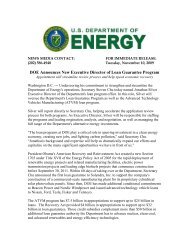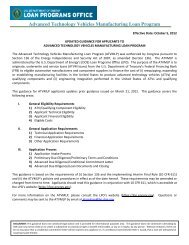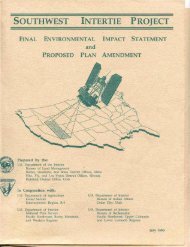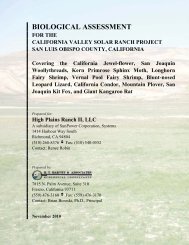Bureau of Land Management's Decision Record and Environmental
Bureau of Land Management's Decision Record and Environmental
Bureau of Land Management's Decision Record and Environmental
Create successful ePaper yourself
Turn your PDF publications into a flip-book with our unique Google optimized e-Paper software.
Jersey Valley Geothermal Development Project<br />
<strong>Environmental</strong> Assessment: NV063-EAO8-091<br />
The golden eagle is Nevada’s largest resident bird <strong>of</strong> prey, sometimes weighing over twelve<br />
pounds <strong>and</strong> having a wingspan that may exceed seven feet. This bird is highly adaptable, has<br />
world-wide distribution <strong>and</strong> is a common year-long resident <strong>of</strong> the planning area. Golden eagles<br />
feed primarily on small mammals-jackrabbits, cottontails, <strong>and</strong> ground squirrels-though they are<br />
capable <strong>of</strong> taking larger prey (Stamm 2006). There have been many sightings <strong>of</strong> golden eagle in<br />
the Project vicinity, though there are no known nests nearby.<br />
Migratory Birds<br />
Migratory birds may be found in the proposed Project area as either seasonal residents or as<br />
migrants. Provisions <strong>of</strong> the Migratory Bird Treaty Act (16 Usc 701-718h) prohibit the killing <strong>of</strong><br />
any migratory birds, including the taking <strong>of</strong> any nest or egg, without a permit. Executive<br />
Order 13 186, titled “Responsibilities <strong>of</strong> Federal Agencies to Protect Migratory Birds,” was<br />
signed on October 1, 2001 to further enhance <strong>and</strong> ensure the protection <strong>of</strong> migratory birds.<br />
Migratory bird species utilize almost all <strong>of</strong> the Shoshone-Eureka Planning Area during some<br />
time <strong>of</strong> the year.<br />
Bird species include meadowlarks (Sturnella meglectus), horned larks (Eremophilia alpestris),<br />
mourning doves (Zenaidura macroura), <strong>and</strong> barn swallows (Hirunda rustica). Red-winged<br />
blackbirds (Agelaius phoeniceus) <strong>and</strong> killdeer (Charadrius vocferous) were observed near the<br />
two spring areas within the Jersey Valley Unit Area. House finches (Carpodacus mexicanus)<br />
were observed <strong>and</strong> heard along the eastern Jersey Valley Unit Area boundary near the<br />
pinyon-juniper woodl<strong>and</strong>s on the hill slopes.<br />
3.5.2 <strong>Environmental</strong> Consequences<br />
3.5.2.1 Proposed Action<br />
Surface disturbance associated with construction activities would result in the loss <strong>of</strong> wildlife<br />
habitat. The direct displacement <strong>of</strong> wildlife would result from the surface disturbance required<br />
for construction <strong>of</strong> the drilling pads, power plant site, pipelines, transmission line, switching<br />
station <strong>and</strong> access roads. A slight reduction in wildlife carrying capacity would be expected to<br />
occur for some species, but most wildlife would be expected to adjust <strong>and</strong> relocate to similar<br />
habitat that is abundant in the Project vicinity.<br />
The transmission line poles would provide perching sites for raptors. The approximately<br />
27.59-mile-long transmission line would also increase the potential for bird collisions,<br />
electrocution <strong>and</strong> bird mortality. However, Ormat has agreed to adopt transmission line raptor<br />
protection practices which would minimize bird electrocutions with the transmission line <strong>and</strong><br />
reduce bird mortality. Additionally, to prevent perching, (a cone, Kaddas Enterprises type<br />
KE1058 or equal) would be installed on the top <strong>of</strong> each transmission line pole along the entirety<br />
<strong>of</strong> the transmission line (see Figure 12, Figure 13 <strong>and</strong> Section 2.1.11).<br />
Project-generated noise could also keep some animals away from areas directly affected by<br />
surface disturbance during the construction, drilling <strong>and</strong> power plant operations. Other indirect<br />
- 49 -







